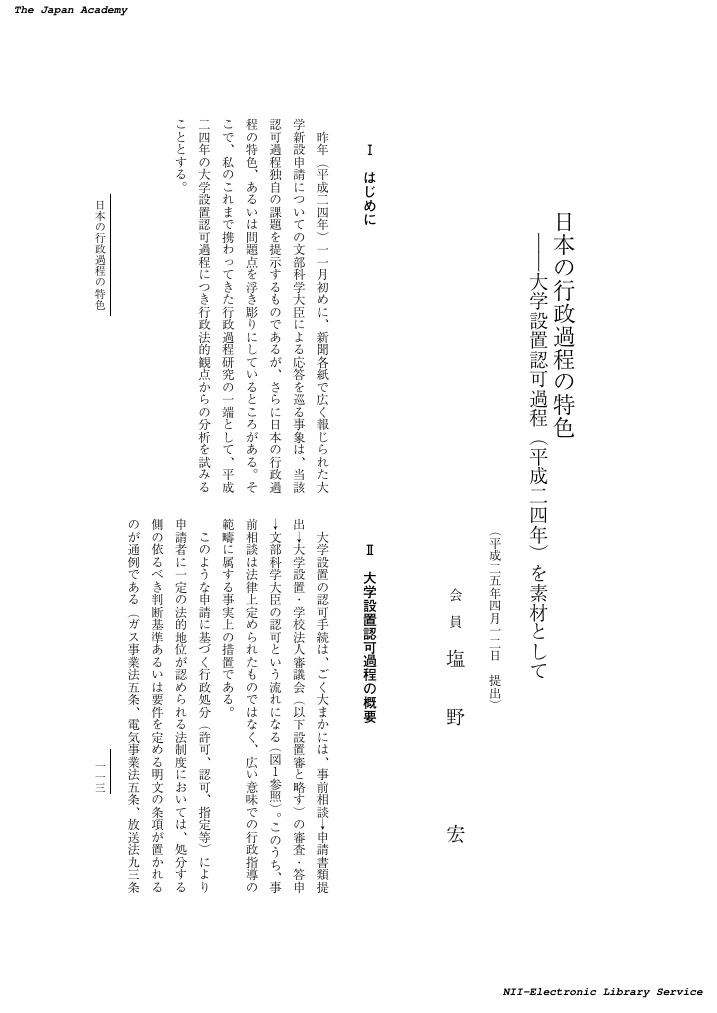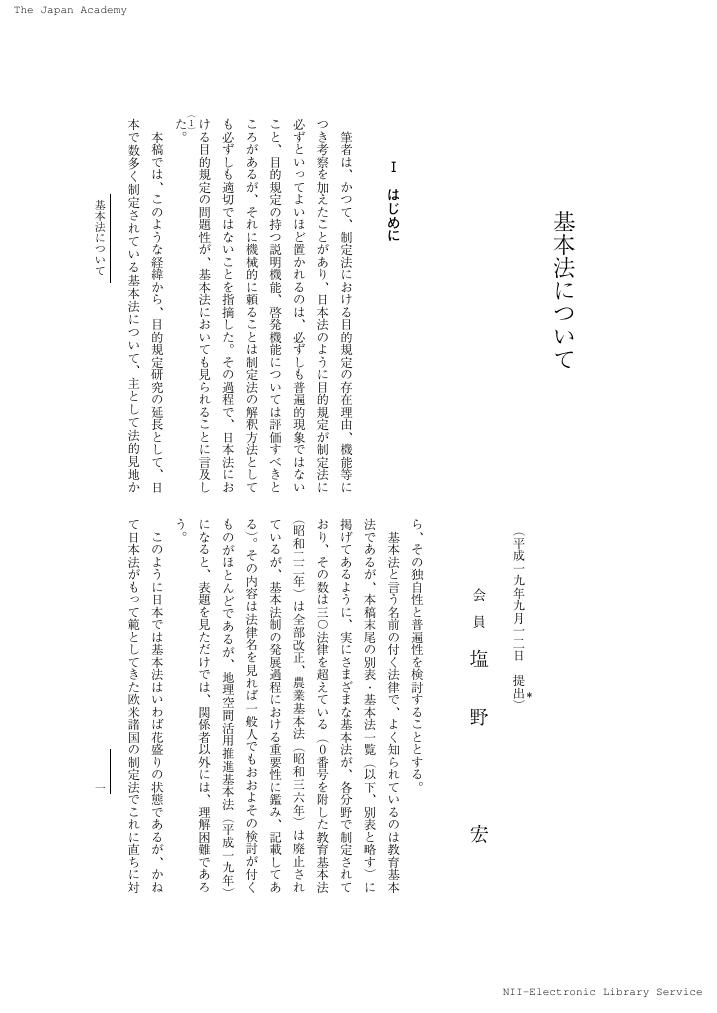67 0 0 0 OA 日本の行政過程の特色--大学設置認可過程(平成24年)を素材として
- 著者
- 塩野 宏
- 出版者
- 日本学士院
- 雑誌
- 日本學士院紀要 (ISSN:03880036)
- 巻号頁・発行日
- vol.68, no.2, pp.113-137, 2014-02
11 0 0 0 OA 行政法学から見た日本学士院
- 著者
- 塩野 宏
- 出版者
- 日本学士院
- 雑誌
- 日本學士院紀要 (ISSN:03880036)
- 巻号頁・発行日
- vol.75, no.2, pp.81-101, 2021 (Released:2021-02-20)
The history of the Japan Academy goes back to the Tokyo Academy that was founded in 1879, up to ten years before the establishment of the Meiji Constitution (1889). When it was founded, it had Western academies as its model. After that it became the Imperial Academy in 1906 through its reorganization under the Meiji Constitution, and carried out activities within the country as an academy, and it also joined the Internationale Assoziation der Akademien (International Association of Academies) in the same year. Under the Constitution of Japan established after World War II (1946), the Science Council of Japan was set up as an institution representing Japan’s scientists in and out of the country. With this, the Imperial Academy was renamed as the Japan Academy and placed within the Science Council of Japan. After that the Japan Academy Act was established, and the Japan Academy drew away from the Science Council and became an independent institution for the preferential treatment of especially accomplished scientists, and it has carried on like this until today. According to the Japan Academy Act, the Academy aims to not only give privileges to scientists, but to also carry out work that is necessary for contributing to the development of science. As part of the international exchange of science, they have joined the Union Académique Internationale (which will henceforth be shortened to “UAI”) and have held the UAI General Assembly in Tokyo in 2017. (View PDF for the rest of the abstract.)
9 0 0 0 基本法について
- 著者
- 塩野 宏
- 出版者
- 日本学士院
- 雑誌
- 日本學士院紀要 (ISSN:03880036)
- 巻号頁・発行日
- vol.63, no.1, pp.1-33, 2008
- 被引用文献数
- 1
6 0 0 0 OA 国立大学法人について (平成一七年六月一四日 提出)
- 著者
- 塩野 宏
- 出版者
- The Japan Academy
- 雑誌
- 日本學士院紀要 (ISSN:03880036)
- 巻号頁・発行日
- vol.60, no.2, pp.67-85, 2006 (Released:2007-06-22)
National universities in Japan, since their establishment under the Meiji Constitution, have been defined as administrative organs of the Ministry of Education or the Ministry of Education and Science. However, the National University Corporations Law of 2002 changed that structure. Effective April 2004, all national universities have been recharacterized as National University Corporations.
4 0 0 0 OA 日本の行政過程の特色--大学設置認可過程(平成24年)を素材として
- 著者
- 塩野 宏
- 出版者
- 日本学士院
- 雑誌
- 日本學士院紀要 (ISSN:03880036)
- 巻号頁・発行日
- vol.68, no.2, pp.113-137, 2014 (Released:2017-04-05)
4 0 0 0 OA 基本法について
4 0 0 0 OA 行政法学における法人論の変遷 (平成一二年一二月一二日 提出)
- 著者
- 塩野 宏
- 出版者
- 日本学士院
- 雑誌
- 日本學士院紀要 (ISSN:03880036)
- 巻号頁・発行日
- vol.56, no.2, pp.49-64, 2002 (Released:2007-06-22)
It varies from country to country and era to era what kind of legal entities take upon public services such as supply of electricity and gas etc. and transportation of passengers and goods. At present, in Japan, the policy of leaving public services, in principle, to the market is being promoted. That is what is called privatization. However, as entities providing services in the market, in addition to the central and local governments, there exist legal entities which can be seen practically as a part of government. How to position these legal entities legally is an important task for the current scholarship on administrative organization law. This thesis analyses the historical process on the argument in the Japanese administrative law about the entities other than central and local governments, which provide public services.
3 0 0 0 OA 行政法における「公益」について : 公益法人制度改革を機縁として
- 著者
- 塩野 宏
- 出版者
- 日本学士院
- 雑誌
- 日本學士院紀要 (ISSN:03880036)
- 巻号頁・発行日
- vol.64, no.1, pp.25-50, 2009 (Released:2017-04-05)
3 0 0 0 OA 行政法概念の諸相 : 中核と周辺
- 著者
- 塩野 宏
- 出版者
- 日本学士院
- 雑誌
- 日本學士院紀要 (ISSN:03880036)
- 巻号頁・発行日
- vol.66, no.1, pp.47-65, 2011 (Released:2017-04-05)
- 著者
- 塩野 宏之 齋藤 寛 今野 陽一 熊谷 勝巳 永田 修
- 出版者
- 一般社団法人 日本土壌肥料学会
- 雑誌
- 日本土壌肥料学雑誌 (ISSN:00290610)
- 巻号頁・発行日
- vol.87, no.2, pp.101-109, 2016-04-05 (Released:2017-06-17)
- 参考文献数
- 33
- 被引用文献数
- 4
In cold regions of Japan, rice straw residues cut and scattered in late autumn are often incorporated into paddy soils the next spring. Generally, emissions of methane (CH4) from such paddy fields are very high owing to rapid anaerobic decomposition of the straw under flooding. We investigated the effects of incorporating straw by shallow tillage in autumn to decompose under aerobic conditions for reducing emissions of the greenhouse gases CH4 and nitrous oxide (N2O). Three plots were prepared: shallow tillage in autumn by plowing at 5–8 cm depth (STA), conventional tillage in autumn by plowing at 18–20 cm depth (CTA), and conventional tillage in the next spring by plowing at 18–20 cm depth (CTS). The study was conducted from 2010 to 2013. In the STA and CTA plots, the straw was incorporated in October, and the plots were plowed the next April. In the CTS plot, the straw was incorporated at plowing in April. All plots were irrigated and rice seedlings were transplanted in late May. CH4 and N2O fluxes were measured by the closed chamber method throughout the cropping period. Tiller number, grain yield, and brown rice quality were also measured. The cumulative CH4 emissions increased in the order of STA (19.9–85.6 g CH4 m-2) < CTA (24.8–107.6 g CH4 m-2) < CTS (45.6–134.1 g CH4 m-2). N2O emissions in all plots were negligible. Tiller number was higher in the STA plot than in the other plots. There were no significant differences in grain yield or brown rice quality. From the time of snowmelt in March to plowing in April, the soil moisture and the concentration of ferrous iron (Fe2+) in soil were lower in the STA plot than in the CTA plot. Consequently, shallow tillage in autumn by plowing at 5–8 cm was the most effective technique for reducing emissions of greenhouse gases from paddy fields with incorporated rice straw in a cold region of Japan.
2 0 0 0 OA 行政法概念の諸相 : 中核と周辺
- 著者
- 塩野 宏
- 出版者
- 日本学士院
- 雑誌
- 日本學士院紀要 (ISSN:03880036)
- 巻号頁・発行日
- vol.66, no.1, pp.47-65, 2011-09
1 0 0 0 OA 制度論 : 電気通信法制の展開過程(<特集>高度情報化社会論(3))
- 著者
- 塩野 宏
- 出版者
- 日本マス・コミュニケーション学会
- 雑誌
- 新聞学評論 (ISSN:04886550)
- 巻号頁・発行日
- no.33, pp.26-39, 1984-06-01






